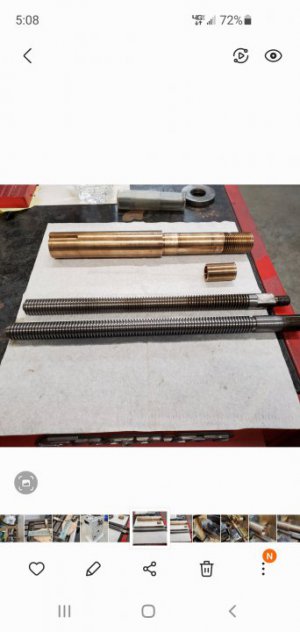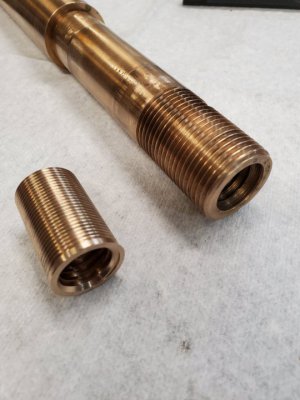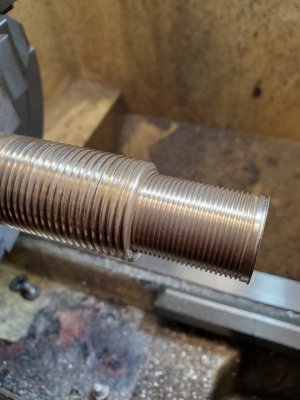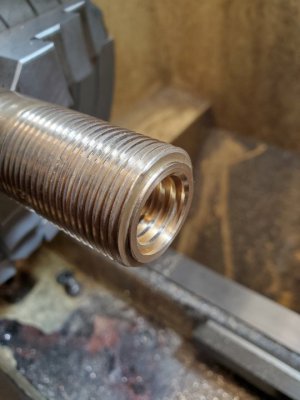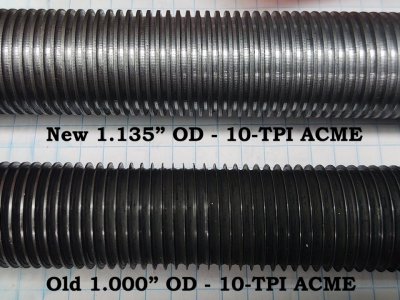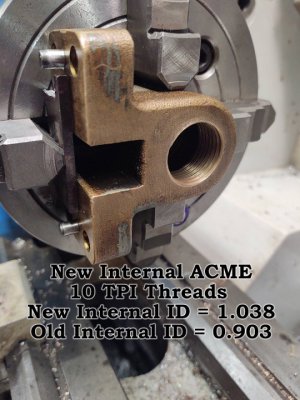Hello, Saxguy

I just dealt with the same issue on my DoAll DH-612 manual surface grinder, mine had roughly .075" worth of backlash (1.9mm) which is right at 3/4 of a turn of the handwheel. Mine is 10TPI or .100" per revolution (2.54mm per revolution), when I took it apart I noticed that the thread thickness on the lead screw was only about .025" thick on the screw and in the nut (roughly .6mm).
I made the mistake of putting my finger inside the nut and I cut my finger slightly because the threads were so sharp, you would think I would have known better than to do that!! Lol
Anyway, there are no replacement parts for mine since DoAll quit making them and there are no aftermarket parts that I'm aware of so I had to make a new lead screw out of 4140.
Instead of making a threaded bushing for the nut, I decided to make the lead screw about .135" larger, there was plenty of bronze left on the nut for a larger diameter lead screw and nothing else restricted me from doing that.
I had to take mine apart to rework the ways and the oiling system anyway, fortunately, mine is much less complex than yours!
Nice looking grinder BTW!!!
With your J&S, I would think that a minimal amount of backlash is a MUST since it has auto feed.
Mine is manual feed in all directions but 3/4 of a turn backlash was just too much! In fact, the X axis would completely quick working soon if I had left it alone.
I would think that a ball screw would be hard to keep from getting crunchy if even a slight amount of grinding swarf gets onto those balls (just a thought, I have very little experience with retrofitting surface grinders).
Grinding swarf is what caused all the damage on mine so my main goal now is to mitigate the grinding swarf by either adding a good vacuum system close to the wheel or maybe a better coolant recovery setup? Whatever it takes to keep that nasty swarf from eating up parts that are in contact with each other is the goal.
I don't plan to install a DRO as someone suggested, I use a test indicator on a mag base for sidewall grinding and that works pretty well for me.
Mine does have a gib lock on the X axis and that helps for sidewall grinding.
BTW, trying to take up backlash on worn lead screw threads doesn't usually work because the threads will bind when the lead screw moves into an area where the wear is less. If the only wear is in the nut, then it would work.
Questions:
1 - Do you have any repair manual drawings or a web link to a replacement lead screw and nut for your grinder?
2 - Is this the lead screw and nut that you need?
https://www.andmar.co.uk/spares-82-saddle-cross-screw-and-nut
3 - Roughly how long is the lead screw is on yours?
4 - When you retract the lead screw to a portion where there is less wear, how much backlash do you observe?
The reason I ask is this: if there is very little backlash where there are less worn lead screw threads, that would mean that the nut has fairly good threads, if the backlash is only slightly less, then the threads in the nut are worn somewhat equally .
I've seen cases where the lead screw is softer than the bronze nut (Not hardened maybe or just soft steel?).
I plan to send y new one out to be hardened and tempered by a pro, if I do the hardening, it would probably wind up NOT straight anymore!! :-D
This hobby/business always has it's challenges and expenses!
Sorry for the long response, just trying to help if I can.

